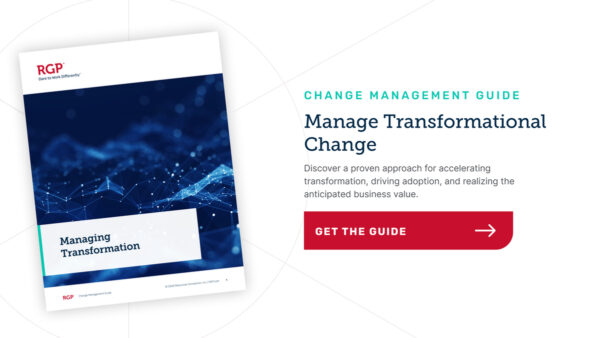Industries
share article
Modern cloud-based ERP systems play a central, critical role in supporting an agile, future-ready business that can respond nimbly to disruption and changing needs. As highlighted in our previous article, cloud ERP deployment has entered a second wave — one that is more measured and strategic. To reap the benefits, you must first execute a successful migration.
Implementing a new ERP system can be a harrowing proposition, but it doesn’t need to be. For more than 20 years, RGP has helped organizations with hundreds of system implementations and upgrades and we are actively supporting the deployment of second-wave systems. Below, we share some of the wisdom we’ve gained that can help speed time to value, maximize ROI, and ensure the deployment process is as smooth as possible.
Read part one of this cloud migration series: How a Strategic Second Wave of Cloud Migration Drives Innovation & Efficiency
Ensuring C-Suite and Board Sponsorship
C-suite and board support is vital in providing “air cover” for a second-wave cloud ERP deployment. It’s no longer enough to have just the CIO on board. The deployment will have a significant learning curve, challenging many employees to change entrenched ways of working and presenting opportunities to innovate.
Companies that outperformed were 32% more likely than others to have active CEO sponsors.
Broad corporate leadership support helps ease resistance to change. For the workforce, it underscores the system’s strategic role in advancing the organization’s objectives. A recent McKinsey study found that companies that outperformed on their cloud ERP implementation were 32% more likely than others to have active CEO sponsors who work communication into their strategies.
For instance, the CEO at one company surveyed by McKinsey pressed the case for cloud adoption, setting a top-down strategy and communicating with the entire company in written updates and town halls. Employees knew that the cloud strategy had the CEO’s direct support. Veracity this further in our recent Dynamic Workforce report, asserting that the triumvirate of CEOs, CFOs, and CHROs is critical to the most ambitious digital transformation projects.
Mastering Phase Zero
For many organizations, it is tempting to quickly get to work installing a cloud ERP. “Why burn so much time planning?” a misguided manager might ask. The reason is straightforward and fundamental: Failing to thoroughly commit your team to the initial “phase zero” groundwork can be a fatal mistake. To avoid the risks of project failure it’s critical to ensure your organization is ready to transform and adopt the new ways of working.
Phase zero establishes the bedrock foundation for a cloud ERP deployment. Team leaders thoroughly analyze the prospective ERP and its goals across the organization. They explore what the future state will bring and what success will look like. They detail the system’s requirements, create a target operating model, and establish a true north. Then, they identify the optimal tools and technologies and consolidate to reduce the overall architectural footprint. Finally, they create a compelling business case focusing on the desired outcomes and developing KPIs to measure success.
“The more time you spend in phase zero, the less time you’re going to spend in deployment because you’re going to get it right the first time, said Mike Knapp, Senior Director of Supply Chain Operations at Solidigm, speaking on a recent RGP webcast. “It calls for a mindset shift, where you imagine and design a future state rather than merely upgrading what you’ve done in the past.”
Finding and Upskilling Talent
Second-wave ERP delivers new systems, processes, insights, innovations, and so on. To capitalize on these benefits, your organization’s talent needs to be prepared. This means taking stock of how jobs will change and what new skills will be required. It means fully understanding the type of talent needed and developing or hiring to fill gaps.
Your organization needs to formulate a communications and training strategy to upskill the existing workforce and to enable employees to operate the updated capabilities. This talent upgrade must occur not just once, when the transformation is delivered, but continuously as teams start using it and until the new expectations are met. Putting the right team in place is as essential as getting the technology right, which is why the CHRO’s active support is critical. Attempting to transform without the requisite team and preparation will yield an underused or misused system.
Developing a Global Framework
A cloud ERP can dramatically improve the efficiency and effectiveness of a multinational organization, given that it enables the same system, with a single source of truth, to be easily accessed from anywhere. Yet implementation also raises unique challenges for multinationals: language, culture, distance, discrete regulatory regimes, and unsynchronized workdays, to name a few.
We have found that rather than going live globally, it often works better to build a framework in a pilot country or region while seeking to understand the global implications. For instance, a multinational bank or healthcare organization would want to consider how privacy or security requirements differ between the US and the European Union and decide whether the whole system should comply with the strictest regulatory requirements or be compartmentalized to meet local standards.
Once the organization has proven the implementation in the pilot location and has a strong understanding of local and global nuances, it can start rolling the system out in other regions. Of course, this always requires collaboration with a knowledgeable local team.
Keeping Hurdles and People in Perspective
As with any large project, no second-wave cloud ERP implementation goes precisely as planned. Inevitably, technical and non-technical hurdles emerge — issues that the team had not anticipated in phase zero. Similarly, it is rare for project teams to be staffed solely by constructive problem solvers. More commonly, they comprise proactive forward thinkers and naysaying pessimists, with vacillators in the middle trying to figure out which side to join.
We have found that polling a sample of team members from all of these camps can reveal the hurdles, empowering leaders to prioritize the more pressing ones. Addressing these issues will often alleviate those that will matter further in the future, enabling leaders to convert naysayers and vacillators into true believers. By doing this, you can resolve anxiety and doubt, aligning the whole team behind the project’s goals.
Viewing Transformation as a Journey Rather Than a Project
Remember when you bought your first smartphone? It came loaded with a bunch of apps that you learned to use. Today, you’re still using those apps, and only those apps, right?
Wrong.
If you’re like most of us, you’re regularly updating your operating system, downloading new apps, and learning to use novel features. The same holds for cloud ERP systems. Yes, they are transformative, but the transformation does not happen at a point in time. It’s ongoing, progressive, and evolutionary. “Following the pandemic, companies are realizing they need to be transforming continuously to keep on top of where they need to be in the marketplace,” observed Rav Chowdhary, Vice President of Project Consulting Services for Veracity in Europe.
“Adoption is like a secret sauce. The more people are on board, the less they resist the change. The real magic happens when the plans turn into actual benefits.”
But this continuous transformation doesn’t just impact your systems, it also impacts your people. It’s not enough for the system to work — employees need to embrace new ways of working and different ways of thinking. This is why it is critical to plan for the “people part” of transformation. “Adoption is like a secret sauce. The more people are on board, the less they resist the change,” says Patricia Reyes, Veracity Vice President, Change Management, noting that resistance can be costly. “You can have the best technology and tools, and if it’s not adopted and sustained, then you haven’t fully achieved your transformation goals,” she says. “The real magic happens when the plans turn into actual benefits.”
Demonstrating Early Wins
Change is difficult. It takes energy. Like a gymnast who takes a running start before launching herself in the air, you need to build momentum before the ERP transformation will take flight. Organizations can do this by developing a roadmap for how the system supports the business strategy, breaking down the core components and (most importantly) achieving quick wins. Examples of wins include faster quarterly closes, more accurate forecasting, greater process efficiency, and automation of tedious tasks; the latter may dramatically improve morale.
In demonstrating these wins, you convincingly and conspicuously show the system’s value. This builds support within your workforce and drives momentum for further transformation. It answers the question that many employees will have: what’s in it for me? The organization may have a grand vision, but achieving it requires the participation of individuals and teams. By showing how the system can improve efficiency and outcomes for employees, you gain their support.

Ensuring the Cloud ERP Achieves Its Potential
After going live, some organizations are tempted to wait and see, hoping that over time, adoption will pick up speed. The business case for the cloud ERP may have, for example, a two-year return on investment. Rather than waiting two years to learn that the system has underperformed, it’s worth monitoring real-time usage data to assess progress.
Successful transformation requires continuous improvement, and with the volume of data available these days, you can easily track the status of that improvement. At an individual employee level, managers can see, for instance, how long a process takes or whether someone is logging into the system when they should. With this real-time visibility, you can determine where people or processes are stuck and adapt the approach as needed, for instance by adding training or tweaking the technology.
Communicating Expectations with Customers
ERP systems are powerful, partly because they encompass and organize many aspects of a large, multifaceted organization. As such, they are inevitably complex. While an ERP system brings many benefits, everything may not run smoothly the moment it goes live. For instance, a technology company was initially unable to confirm orders because they could not get supply into the system.
Because of this, it is essential to communicate with customers and suppliers and manage their expectations so that they can plan accordingly. Let them know what you’re doing when you can expect possible disruption. Work with them to prepare. And once you go live, proactively keep them informed of your progress. Remember: successfully deploying a second-wave cloud ERP requires your whole ecosystem to take a journey with you.
Next Steps
Deploying a second-wave cloud ERP is a major undertaking for any business. Having witnessed and participated in the transformation resulting from such undertakings, we are confident that the benefits justify the investment and effort — as long as your organization follows best practices, including those we have outlined above.
To reap the benefits of a second-wave cloud ERP, many organizations will need to deploy a new system. This can be a harrowing proposition, but it doesn’t need to be. For more than 20 years, Veracity has helped organizations with hundreds of system implementations and upgrades. Today, we are actively supporting the deployment of second-wave systems.
If you are exploring the possibility of implementing a cloud ERP system, please feel free to contact us to discuss the process in more detail.





